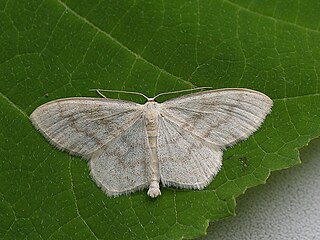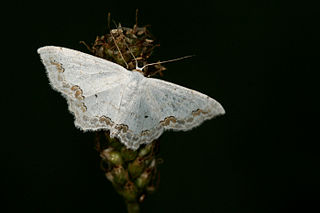
The cream wave is a moth of the family Geometridae. The species was first described by Adrian Hardy Haworth in 1809. It is found in forest and woodland regions, feeding on grasses and small plants such as dandelion.

Scopula decorata, the middle lace border, is a moth of the family Geometridae. It is found throughout Europe.

Scopula immorata, the Lewes wave, is a moth of the family Geometridae. It is found throughout Europe and the Near East.

Scopula is a genus of moths in the family Geometridae described by Franz von Paula Schrank in 1802.

Scopula ornata, the lace border, is a moth of the family Geometridae. The species was first described by Giovanni Antonio Scopoli in his 1763 Entomologia Carniolica. It is found in Europe, North Africa and the Near East.
Scopula annularia is a moth of the family Geometridae first described by Charles Swinhoe in 1890. It is found from the north-eastern Himalayas to Hong Kong, Myanmar, Sumatra, Borneo, Java, the Philippines, Sulawesi and Seram.
Scopula asellaria is a moth of the family Geometridae. It was described by Gottlieb August Wilhelm Herrich-Schäffer in 1847. It is found in southern Europe and North Africa.
Scopula subpunctaria is a moth of the family Geometridae. It is found from northern and north-eastern China to the southern Palearctic realm.
Scopula prouti is a moth of the family Geometridae. It is found from north-eastern China to Korea, Japan and south-eastern Russia.
Scopula indicataria is a moth of the family Geometridae. It is found in China, Korea, Japan and Russia.

Scopula beckeraria is a moth of the family Geometridae. It was described by Julius Lederer in 1853. It is found in Italy, Croatia, North Macedonia, Greece, Bulgaria, Romania, Ukraine, Russia, Turkey, Armenia, Israel, Lebanon, Iran, Turkmenistan and Kazakhstan.

Scopula caesaria is a moth of the family Geometridae. It has a wide range, including the Comoros, Mayotte, La Réunion, Madagascar and in Mauritius, Nigeria, South Africa, Tanzania, Gambia, Oman, the United Arab Emirates, New Guinea, Taiwan, Japan and Australia (Queensland).
Scopula erici is a moth of the family Geometridae. It is found in Uganda and the Republic of Congo.
Scopula flaccata is a moth of the family Geometridae. It is found in the Palestinian Territories, Israel, North Africa and has recently been recorded from southern Europe.
Scopula gastonaria is a moth of the family Geometridae. It was described by Oberthür in 1876. It is endemic to Algeria.
Scopula impersonata is a moth of the family Geometridae. It is found in China, the Russian Far East, Taiwan and Japan.
Scopula moralesi is a moth of the family Geometridae. It is found in Morocco.
Scopula perstrigulata is a moth of the family Geometridae. It is found in South Africa and Zimbabwe.
Scopula sideraria is a moth of the family Geometridae. It is found in western North America, from southern British Columbia to San Diego County, California.
Scopula superciliata is a moth of the family Geometridae. It was described by Prout in 1913. It is endemic to Japan.






